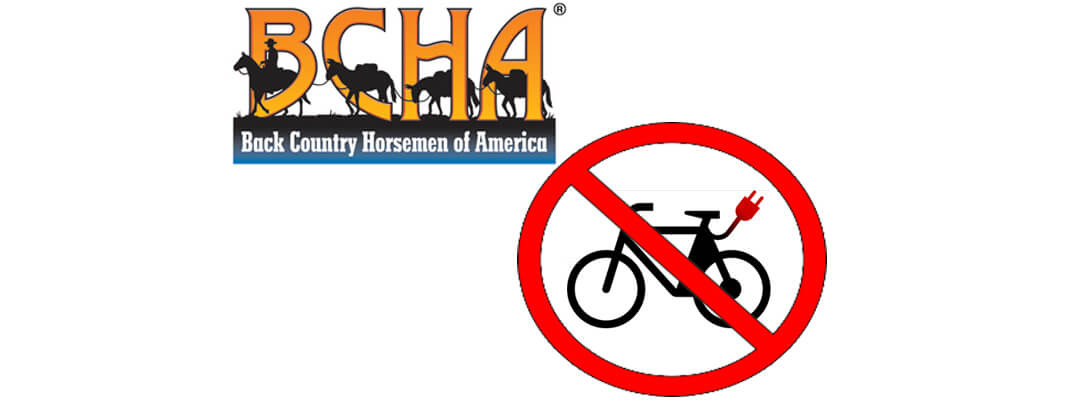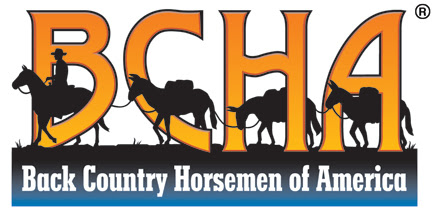BCHA has been diligently working the past two months on the rapidly-evolving issue of electric bike (e-Bike) use on federal public lands. Please see our two-page fact sheet that describes what BCHA and our partners are doing to prevent e-Bikes from being universally authorized on non-motorized trails within our national parks, national forests and BLM public lands.
As always, if you have concerns regarding this issue, I encourage you to share your concerns in writing with your local land managers and/or elected officials. Given that this issue is heating up, I ask that you please copy BCHA’s Director for Public Lands & Recreation on any such correspondence. His email is: [email protected]
Prevent Electric Bikes on Non-Motorized Trails
Secretary of Interior Declares: A Motor is Not a Motor
On August 29th, 2019, the Secretary of the Department of Interior (DOI) issued Secretarial Order 3376, titled “Increasing Recreational Opportunities through the use of Electric Bikes.” The Order applies to all DOI agencies—the National Park Service, BLM, and U.S. Fish & Wildlife Service. Essentially, it orders the agencies to adopt policies that declare electric bikes (e-Bikes) a non-motorized trail use. It states: E-bikes shall be allowed where other types of bicycles are allowed; E-bikes shall not be allowed where other types of bicycles are prohibited (Section 4(b)(c)).
Wilderness Areas Exempt
The Order does not, and cannot by law, apply to trails in federally-designated Wilderness areas. Yet e-Bikes soon could be sharing backcountry trails with horsemen. The U.S. Forest Service is also considering policy changes that would yield a similar result. Yet, by enshrining falsehoods into agency policy comes the risk of creating a slippery slope with respect to what type of machines might be allowed anywhere.
Worse of all, the Department never provided the public an opportunity to comment on this Order. It’s the result of behind-closed-door negotiations with lobbyists representing bike and electric motor manufacturers. The opinion BCHA, hikers, hunters, anglers, etc. was not sought or deemed important.
Background
To date, e-Bikes have been marketed primarily as an option for city commuters or as an alternative form of transportation or outdoor recreation for the elderly. Yet the e-Bike you’re bound to see on the trail is a different beast: envision a beefy mountain bike with a thick down tube and a slightly larger crank case.
They are called electric mountain bikes (eMTBs) and the motor is barely detectable. Inside the frame is a rechargeable battery capable of accelerating its rider to speeds up to 28 mph, with current ranges from 50-75 miles. Some, like the makers of the Optibike (www.optibike.com), claim a range of 180 miles.
The Secretarial Order applies to the current three classes of e-Bikes (Class 1, 2 and 3), where Class 2 uses throttle-assist, like a motorcycle — no pedaling required — and Class 3 is capable of achieving speeds of 28 mph before the motor assist kicks off. This brings into serious question whether law enforcement officials on federal public lands could effectively enforce these subtleties out among our trails.
Now, in addition to scanning the hillsides ahead of us for descending mountain bikes, will horsemen and women soon need to constantly scan the trail behind us—no matter how steep the slope we are ascending?
BCHA Leading the Charge
BCHA helped sound the alarm in late June. We were quickly joined by our partners, including The Wilderness Society (TWS), the American Hiking Society, and the Pacific Crest Trail Association. We submitted a letter in late July to agency leaders that carried the support and signatures of over 60 regional and national trail- and recreation-oriented organizations, plus a listing of 30 BCH states and 196 chapters. It expressed, in no uncertain terms, our unified opposition to any change in agency policy that would authorize e-Bikes, which clearly are motorized vehicles, on non-motorized trails.
We issued a joint press release on August 30, 2019, immediately upon posting of the Secretarial Order. It garnered national media attention via the Associated Press and other outlets. We also issued a joint press release with Backcountry Hunters & Anglers, which was covered by the media in Cody, WY.
How Might this Play Out?
What does the Secretarial Order mean for the multi-use trails that horsemen and women currently enjoy? It’s hard to gauge at the moment. Here is a break-down by federal agency.
National Parks: It could force National Park Service superintendents to declare, via updates to the “Superintendent’s Compendium,” that e-Bikes and eMTBs are authorized on trails where mountain biking is already allowed. That process does not require public input, but Superintendents would be wise to first do so if they don’t initially reject the premise of the illogical Order.
The list of national park units that have mountain bikes trails is not long. But the policy change could represent a game-changer in park units like Mammoth Cave National Park; Big South Fork National River and Recreation Area; and the Chattahoochee River, Golden Gate, Santa Monica Mountains, and Whiskeytown national recreation areas.
BLM Lands: Conversely, there are many trails on which mountain bikes are allowed at present on Bureau of Land Management (BLM) lands, which are extensive throughout the 11 Western States. Yet existing BLM policy would seem to prevent the instant authorization of motorized uses, like e-Bikes, on non-motorized trails. It appears the agency would first have to enter into a public decision-making process, like a trails or travel plan on a case-by-case and site-specific basis, including full public involvement.
National Forests: Fortunately, the U.S. Forest Service resides within the U.S. Department of Agriculture, and not within DOI. So the new Secretarial Order does not apply to the Forest Service. But the Forest Service has received a similar level of lobbying by the same bike and electric motor lobbyists. Plus, the Secretary of Interior is applying pressure to make the new e-Bike policy consistent among all federal land management agencies. BCHA and its partners are not sitting by idly.
In early September, BCHA joined forces with TWS to demand that the Tahoe National Forest rescind its recent action to allow Class 1 eMTBs on over 130 miles of non-motorized trails throughout the forest. The “decision” was announced quietly and without any public scoping or public meetings. Even the local chapter of BCH California, the Mother Lode Unit, and another local equine trails organization, were left in the dark, despite maintaining good relations with Tahoe forest staff. Proponents of eMTBs hailed the Tahoe National Forest as a “pilot” project among national forests, with more to come.
BCHA Prepared to Litigate
Our September 9 “demand letter,” submitted to the Tahoe National Forest by TWS, BCHA, BCH California, its Mother Lode Unit and two other local organizations, lays out a legal case for why the action to allow eMTBs on non-motorized trails was in violation of existing law and policy. It serves as a courtesy notice to our partners within the agency to do the right thing by rescinding the illegal action and cease advertising on its website this new regional, eMTB playground.
Litigation via the Federal Courts is the last thing BCHA would choose to do, particularly with a key partner like the Forest Service. It strains relationships, represents an enormous sink of time and money, and does not always yield the results we want, nor in the timeframe we might want, even if we were able to convince a federal judge of our claims.
Electric bikes have their place on public lands. Moreover, they provide a segment of the public with opportunities to explore and enjoy public lands who might not otherwise have such an opportunity.
Nonetheless, a motor is a motor is a motor. They have no place on non-motorized trails. The U.S. Forest Service alone has 60,300 miles of legally designated motorized trails on which e-Bikes and eMTBs are currently allowed (not roads, but actual trails). One can only hope for a rational solution. But if this one-sided favoritism persists, the options for BCHA, our partners and for all trail users to be able to influence public lands policy will continue to be very limited if we don’t act now.

News from the horse industry. Sharing today’s information as it happens. The Northwest Horse Source is not responsible for the content of 3rd party submissions.






